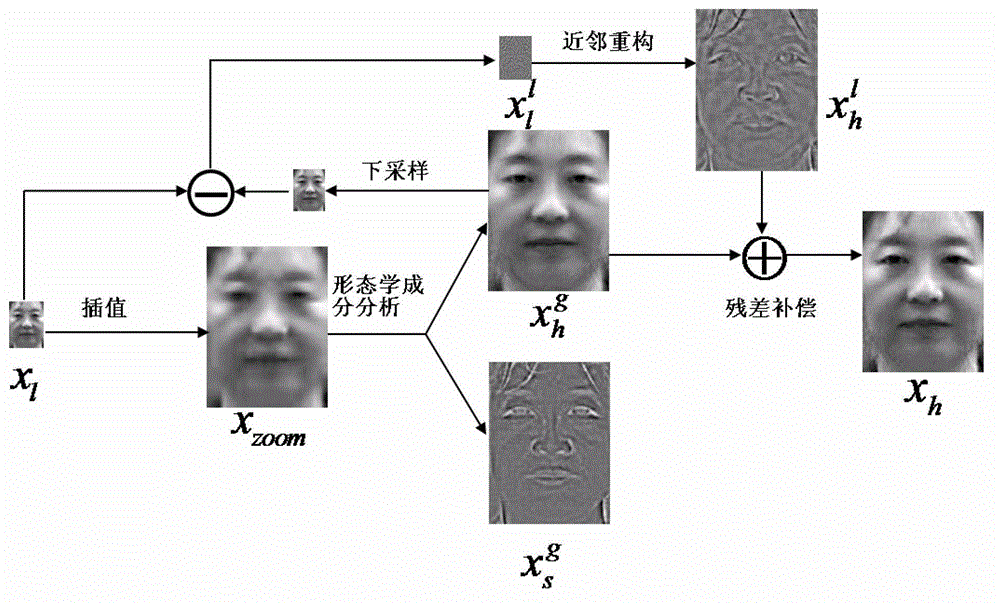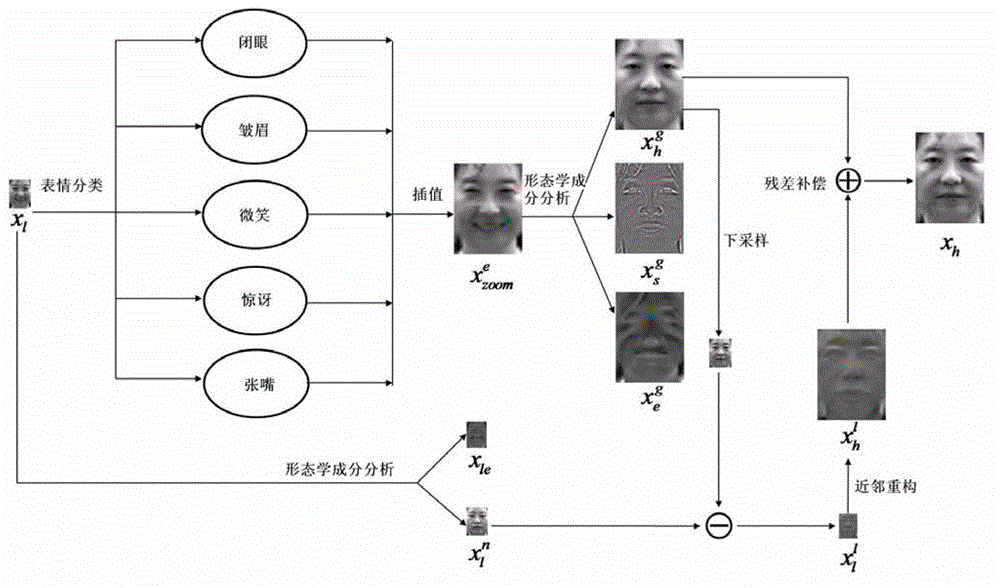Face image super-resolution reconstruction method based on morphological component analysis
A super-resolution reconstruction, morphology-based technique for image processing
- Summary
- Abstract
- Description
- Claims
- Application Information
AI Technical Summary
Problems solved by technology
Method used
Image
Examples
Embodiment 1
[0057] Such as figure 1 As shown, the face image super-resolution reconstruction method based on morphological component analysis includes the following steps:
[0058] (1) Upsampling the low-resolution input image by interpolation method to obtain the interpolated image;
[0059] (2) Using the morphological component analysis method to decompose the interpolated image obtained in step (1) into an overall high-resolution face image and an unsharp mask;
[0060] (3) Downsample the overall high-resolution face image obtained in step (2), and then subtract it from the low-resolution input image to obtain a low-resolution residual image, and then pass each of the low-resolution residual images Perform neighbor reconstruction on the image block at the face position to compensate the face detail information of the image to obtain a high-resolution residual image;
[0061] (4) Merge the high-resolution residual image in step (3) with the overall high-resolution face image obtained ...
Embodiment 2
[0080] The structure of this embodiment is the same as that of Embodiment 1 except for the following features: based on the multi-channel decomposition capability of the morphological component analysis method, the expression changes in the morphological component analysis are modeled by designing a dictionary, and the algorithm is extended to simultaneously process human face images Super-resolution and expression normalization. A face image super-resolution reconstruction method based on morphological component analysis, comprising the following steps:
[0081] (1) Set five basic facial expressions: eyes closed, frown, smile, surprise, mouth open. Through the method of principal component analysis, the five kinds of expressions are learned to obtain a dictionary of expressions that are not related to each other, as follows:
[0082] (1-1) For each expression, randomly select different face high-resolution images of this expression and the corresponding high-resolution image...
Embodiment 3
[0091] The structure of this embodiment is the same as that of Embodiment 1 except for the following features: In this embodiment, based on the face image super-resolution reconstruction method based on morphological component analysis, all low-resolution input images are processed by a classifier before processing Judge whether its human face has expression, if not, then adopt the method described in embodiment 1 to process, if have expression, then adopt the method described in embodiment 2 to process.
[0092] The present invention illustrates the effects of the present invention through the following experiments: the CES-PEAL-R1 face database is selected in the experiment, and the database contains 99,594 images of 1040 people. The position is simply calibrated. As shown in Table 1, 5 subsets of frontal images are used in two experiments, and some existing methods are also implemented for comparison:
[0093] Table 1. Contents of the 5 subsets of the CAS-PEAL-R1 database ...
PUM
 Login to View More
Login to View More Abstract
Description
Claims
Application Information
 Login to View More
Login to View More - R&D
- Intellectual Property
- Life Sciences
- Materials
- Tech Scout
- Unparalleled Data Quality
- Higher Quality Content
- 60% Fewer Hallucinations
Browse by: Latest US Patents, China's latest patents, Technical Efficacy Thesaurus, Application Domain, Technology Topic, Popular Technical Reports.
© 2025 PatSnap. All rights reserved.Legal|Privacy policy|Modern Slavery Act Transparency Statement|Sitemap|About US| Contact US: help@patsnap.com



